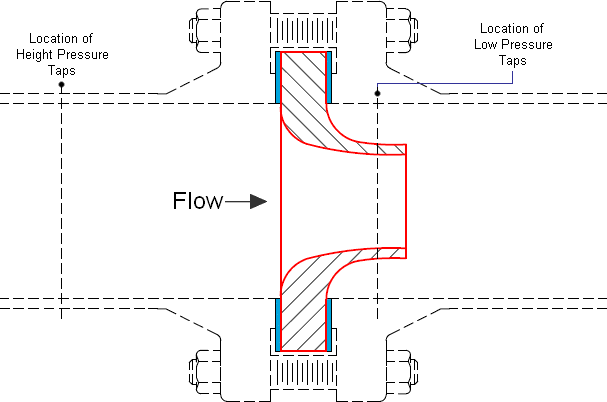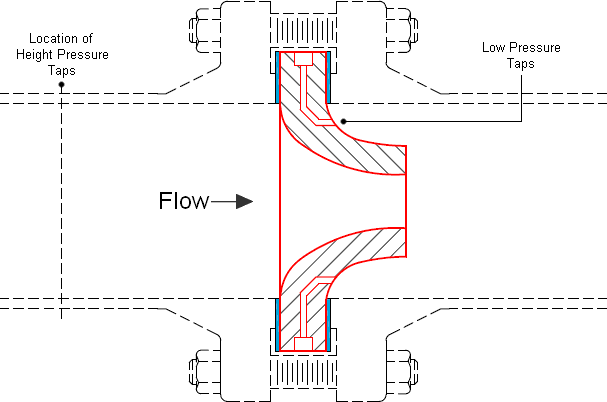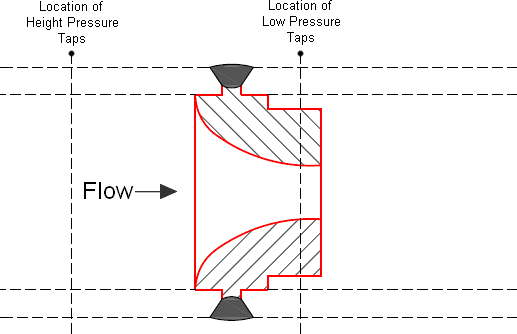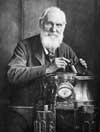Pipe Flow Measurement.. Flow Nozzles
Why measure Flow?
In many of today's industrial processes, it is essential to measure accurately the rate of fluid flow within a system as a whole or in part. This applies equally to gases and liquids (e.g. carbon dioxide, nitrogen, liquors etc.) which are an integral part of the process, or to compressed air, water or steam which are fundamental to plant operation. The installation of any flowmeter can be justified in one of two ways..
1. Process control
Here the flowmeter is used to measure the rate of fluid or energy flow to allow the process to be controlled and so ensure that the end product is of the required quality. A common example of this would be in steam injection systems for the animal feeds industry...too much steam and the product will not pellet...too little steam and the raw materials will not process and may damage the production machinery.
2. Cost allocation
Where energy is used to provide process or space heating, it is fundamental to know where the costs associated with the energy are actually being incurred. Flowmetering allows energy costs to be allocated to a particular product, department or other user this usually resulting in a significant reduction in total energy costs.
Understanding Pipe Flow Rate
The term pipe flow rate is often used to refer to flow rate for any closed conduit flow under pressure. The closed conduit is often circular, but may also be square or rectangular, such as a heating duct. The other major category of flow is open channel flow, which occurs when there is a free liquid surface open to atmospheric pressure.
Measurement of the flow rate of a fluid flowing under pressure is carried out for a variety of purposes, such as billing for water supply to homes or businesses, or for monitoring or process control of a wide variety of industrial processes which involve flowing fluids.
Pipe flow measurement is often done with a differential pressure flow meter like the orifice, flow nozzle, and ventruri meter.
For each type, a constriction in the flow path causes a pressure drop across the meter. The pressure drop can be measured and correlated with flow rate.
Flow Nozzles
Flow nozzles are often used in flow measurement due to their reliable performance and tolerance to extremes in process and environmental conditions. They offer advantages over orifice plates in that they require less upstream piping and incur lower permanent pressure loss. Accuracy can be sustained indefinitely since there are no sharp edges to wear.
Flow nozzles are used in various industries, particularly for steam flow in the power sector. Due to their long documented history, flow nozzle designs and installation requirements are known and recognized by national and international standards organizations.
Application of Flow Nozzles
Flow nozzles are used in a variety of applications where extremes of pressure, temperature, or the aggressive nature of the fluid being metered render other metering technologies unfeasible. Because of their long-term reliability and ease of installation, they are commonly used as the differential pressure device for the measurement of the flow of fluids, especially for water, steam, air, and gases.
Common installations include.. Power Plants, Refineries, Petrochemical Plants, Chemical Processing Facilities, Steam and Condensate Flows etc.
Flanged Flow Nozzles
Flanged flow nozzles are constructed with a mounting flange in line with the contoured upstream face. The mounting flange is sandwiched between the end-users pipe flanges to hold and seal the flow nozzle inside of the process piping. The mounting flange can be provided with a raised gasket face or RTJ groove, as required. Every flanged flow nozzle has a precision-machined shoulder to help assure its concentricity with the adjacent pipe.
A flanged Flow Nozzle is installed between pipe flanges when the customer/end-user is providing the taps for the upstream and downstream pressure sensation. The flow contour is machined to ASME or ISO specifications and a shoulder is provided on the downstream side of the mounting flange to center the nozzle within required tolerances.

Flanged Flow Nozzle with Integral Low Pressure Taps
The Flanged Flow Nozzle with Integral Low Pressure Taps is provided with the downstream tap integral to the nozzle's mounting flange. This design provides the same ASME or ISO flow contour, but can be used in smaller pipe sizes where the low pressure tap may interfere with the pipe weld, flange, and/or flange bolting. The low pressure connection is typically1/4" NPT (6 mm) unless specified otherwise.

Weld-In Flow Nozzles
Weld-In Flow Nozzle is used where pipe flanges are not or cannot be used, such as in high pressure and/or high temperature applications in power plant installations. This flow nozzle design has a small mounting flange designed to fit between beveled ends of the inlet and outlet pipe section. The pipe sections are then welded together with the nozzle in place.

The weld-in flow nozzle design can be provided as a special Mounting Ring Flow Nozzle that eliminates the need for welding dissimilar metals in the field. Note that pipe wall pressure taps are used with this nozzle design and that it is available in complete flow metering section.
For special applications and in smaller line sizes, Weld-In Flow Nozzles with Integral Metering Taps are available. This design may include a short section of upstream and downstream pipe with flanged, beveled, or socket weld ends.
Salient features and benefits of Flow Nozzles
- Widely used for high pressure and high temperature steam flow
- Useful for flow measurement at high velocities
- Rounded inlet not subject to wear or damage, extending product life
- Better sweep-through effect for debris and liquids, eliminate damming effect
- Lower susceptibility to erosion
- Extended product life with no moving parts
Standards for Flow Nozzles, Venturies and Orifices
ISO 5167-3:2003 specifies the geometry and method of use (installation and operating conditions) of nozzles and Venturi nozzles when they are inserted in a conduit running full to determine the flow-rate of the fluid flowing in the conduit.
ISO 5167-3:2003 also provides background information for calculating the flow-rate and is applicable in conjunction with the requirements given in ISO 5167-1.
ISO 5167-3:2003 is applicable to nozzles and Venturi nozzles in which the flow remains subsonic throughout the measuring section and where the fluid can be considered as single-phase. In addition, each of the devices can only be used within specified limits of pipe size and Reynolds number. It is not applicable to the measurement of pulsating flow. It does not cover the use of nozzles and Venturi nozzles in pipe sizes less than 50 mm or more than 630 mm, or for pipe Reynolds numbers below 10000.
ISO 5167-3:2003 deals with two types of standard nozzles, the ISA 1932 nozzle and the long radius nozzle, as well as the Venturi nozzle.
The two types of standard nozzle are fundamentally different and are described separately in ISO 5167-3:2003. The Venturi nozzle has the same upstream face as the ISA 1932 nozzle, but has a divergent section and, therefore, a different location for the downstream pressure tappings, and is described separately. This design has a lower pressure loss than a similar nozzle.
For both of these nozzles and for the Venturi nozzle direct calibration experiments have been made, sufficient in number, spread and quality to enable coherent systems of application to be based on their results and coefficients to be given with certain predictable limits of uncertainty.
BS 1042-1-1.2 standard specifies the measurement of fluid flow in closed conduits. Pressure differential devices. Specification for square-edged orifice plates and nozzles (with drain holes, in pipes below 50 mm diameter, as inlet and outlet devices) and other orifice plates.
Geometry and method of use for conical entrance orifice plates, quarter circle orifice plates and eccentric orifices plates. Also square-edged orifice plates and nozzles outside the scope of BS 1042:Section 1.1.
ASME MFC-3M standard specifies the geometry and method of use (installation and flowing conditions) for orifice plates, nozzles, and Venturi tubes when they are inserted in a conduit running full, to determine the rate of the fluid flowing. It also gives necessary information for calculating flow rate and its associated uncertainty.
It applies only to pressure difference devices in which the flow remains turbulent and subsonic throughout the measuring section is steady or varies only slowly with time and the fluid is considered single-phased. In addition, the uncertainties are given in the appropriate sections of this Standard for each of these devices, within the pipe size and Reynolds number limits which are specified.
It deals with devices for which sufficient calibrations have been made to enable the specification of coherent systems of application and to enable calculations to be made with certain predictable limits of uncertainty. The devices introduced into the pipe are called primary devices. The term primary device also includes the pressure taps and the associated upstream and downstream piping.
All other instruments or devices required for the measurement or transmission of the differential pressures are known as secondary elements, and in combination are referred to as the secondary devices. This Standard covers the primary devices; secondary devices will be mentioned only occasionally.
The following primary devices are covered in this Standard.. (a) orifice plates, which can be used with the following arrangements of pressure taps.. (1) flange pressure taps, (2) D and D/2 pressure taps, (3) corner pressure taps. (b) nozzles.. (1) ASME long radius nozzles. (c) Venturi tubes.. (1) classical Venturi tubes.
This Standard does not pipe or conduit sizes under 50 mm (2 in.) nominal.
This Standard does not apply to ASME Performance Test Code measurements.
The Standard is applicable to measurement of flow of any fluid, (liquid, vapor, or gas).
References
- Spirax-Sarco Limited
- Wyatt Engineering, LLC
- Miller, R.W.. Flow measurement engineering handbook. 3rd Ed. McGraw-Hill Book Co., New York, N.Y.
- USBR. Flow measurement manual. Water resource(s) Publications, LLC. Highlands Ranch, CO.
Remark(s) of the Author...
Baron Kelvin (William Thomson) once said..
"When you can measure what you are speaking about and express it in numbers, you know something about it; but when you cannot measure it, when you cannot express it in numbers, your knowledge is of a meagre and unsatisfactory kind."

Baron Kelvin
In other words, you cannot manage what you cannot measure and nowhere is that more true than in the measurement of flow.